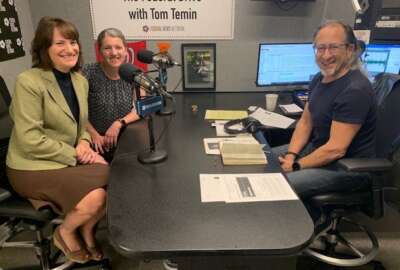This FDA lawyer was instrumental in limits on cigarette marketing
Since the FDA got authority from Congress in 2009 to regulate tobacco marketing, smoking rates in the United States have dropped to 10% for adults and less than 3%...
Best listening experience is on Chrome, Firefox or Safari. Subscribe to Federal Drive’s daily audio interviews on Apple Podcasts or PodcastOne.
Since the FDA got authority from Congress in 2009 to regulate tobacco marketing, smoking rates in the United States have dropped to 10% for adults and less than 3% for minors. Much of the credit goes to not a scientist but a lawyer. Until his retirement this past spring, he was director of the FDA’s Center for Tobacco Products and a finalist in this year’s Service to America Medals program. Mitchell Zeller spoke to the Federal Drive with Tom Temin.
Interview transcript:
Tom Temin: Tell us what happened after this 2009 authority. You were not at the FDA at the time, but you came back to it.
Mitchell Zeller: Right. I had been at FDA during I guess you could call it Tobacco 1.0 in the 1990s, where the agency asserted jurisdiction over the tobacco industry, but was sued. And in a decision made by the Supreme Court in 2000, the Supreme Court overturned the FDA assertion of jurisdiction. It took Congress nine years to put FDA back in the business of regulating tobacco products. And so the world as we know it, at least for the tobacco industry changed in 2009, because for the first time, there was FDA sort of standing as the gatekeeper between the tobacco industry, their marketers, their product developers, and the tens of millions of smokers in the United States, as FDA finally had the regulatory authority to use the tools of product regulation to try to reduce the harm associated with tobacco use.
Tom Temin: And what did you do as an attorney? In other words, you weren’t involved in the chemistry of what’s in a cigarette and how much nicotine and how much tar and all of this, but it had to do with the marketing of cigarettes.
Mitchell Zeller: Well, my legal training really helped me sort of merge where worlds collide, where the worlds of science and law and policy and even the politics, where the intersection of all of that is where tobacco product regulation lives. And when I returned to the agency for my second stint in 2013. At that point, I had been doing FDA-related policy work for little over 30 years. And so I think that the legal training and my first job ever at the Center for Science in the Public Interest, as an attorney helped me figure out especially how to use regulatory science to inform policy.
Tom Temin: And regulatory science, that’s a word you don’t hear as much.
Mitchell Zeller: Right so think of traditional scientific disciplines: chemistry, toxicology, addictions research. That work is going on in trying to better understand tobacco products, the mindset of smokers, and think about how FDA as now a funder of research could put literally hundreds of millions of dollars out there, primarily through the traditional NIH funding mechanism. FDA has a wonderful partnership with NIH to try to further develop what I call this regulatory science, so that we can use the results to figure out how to reduce the harms of currently marketed products for those who continue to use them, but also to inform our thinking about everything that we need to do to prevent future generations of kids from ever experimenting or initiating with any tobacco product.
Tom Temin: And how did this all apply in the marketing zone of tobacco products versus the content of the cigarettes and smoking products themselves?
Mitchell Zeller: So marketing is a really, really important component of what we call the pre-market review for applications for new products that are not currently on the market. And under the law, one of the obligations that the companies have when they submit these applications to FDA on a pre-market basis is they need to tell the agency what they know about who the intended user is for the product. And in the controversial area of electronic cigarettes, each company needs to be able to address the issue of well, what do they know about the popularity of their product with kids? And to the degree that their product is popular with kids, what mitigation steps can they build into marketing plans, were they to ever get an authorization for a product by FDA?
Tom Temin: All right. We’re speaking with Michel Zeller, he’s director of the Center for Tobacco Products at the FDA, and a finalist in this year’s Service to America Medals program. So you had to then convince them to change marketing practices, this is the cigarette companies.
Mitchell Zeller: It’s not so much that we had to convince them to change. It’s if we had concerns on a case-by-case basis. If we had concerns with the popularity of a particular product with kids, then if there was any other basis to say, yes, you’re gonna get a marketing authorization, then we would talk to the companies about what their marketing plans were. But there’s something of a give-and-take there. It’s a non-issue if the agency is going to deny the application. If the agency is going to say no to a product, then the issue of well how would you propose to market is irrelevant. It’s only relevant if the agency is prepared to say yes, you can market this product, in which case we do engage in discussions with companies about their marketing intentions.
Tom Temin: Just the way drug companies are all over the TV newscasts, right, I think as much of an ad as devoted to the warnings about it as there is to the benefits of it, and that’s because of negotiations with FDA?
Mitchell Zeller: Exactly. And at the end of the day, there’s just so much that FDA can compel. So it’s more of a give and take between the agency and the company.
Tom Temin: And how do you decide what can be marketed in the first place?
Mitchell Zeller: That has less to do with what are the marketing intentions of the company, and much more to do with have they submitted the science to the agency in order to meet whatever the relevant statutory standard is? So for electronic cigarettes, the standard is very broad. It’s well, would marketing of this product be, and this is a quote from the statute, “appropriate for the protection of the public health.” What does that mean? Well, it means that you have to have the chemistry, the toxicology, the addictions, science, everything else, the engineering information so that the reviewers at FDA can apply the mandatory considerations that Congress wrote into the statute, which are basically impact likelihoods. What is the likelihood that current users would use the product? What is the likelihood that current nonusers who should not be using the product might start using the products? And are there any safety or harm issues raised when reviewing the chemistry or the toxicology? It’s more of a straightforward scientific review, that the agency has a lot of history in doing, for drugs but also for medical devices and biologics. It’s when the agency gets closer to saying yes, that’s when we get to the issue of oh, well, okay, so it’s a tobacco product. And if it’s an e cigarette, there might be an issue with kids. So what can be done to minimize the unintended consequences, were FDA to say yes to the marketing of a product?
Tom Temin: And in light of the recent Supreme Court decision, say on the EPA, do you have to make sure that you don’t risk getting beyond even the authorization from 2009 to regulate tobacco products, such that you can effectively eliminate them, even though Congress has not rendered them illegal, per se?
Mitchell Zeller: I’m less concerned about the impact of that decision for FDA just speaking for myself, for a couple of reasons. Number one, what you and I have been talking about are adjudications that the agency makes on a case-by-case basis. So that decision I don’t believe applies. That decision is potentially relevant when it comes to making forward looking policy through the rulemaking process. But as long as an agency doesn’t sort of color outside the lines of what the statute authorizes the agency to do, I would like to think that that decision will not have an adverse impact on science-based regulatory agencies like the Food and Drug Administration.
Tom Temin: And you operate a really specialized sounding area of law as it applies to regulation and science and so forth. What’s it like encountering the people from the companies that you are regulating? What are they like, the opposing attorneys?
Mitchell Zeller: Well, you can’t really paint them with too broad a brush. Like all companies within any sector, there are different personalities. Some are much more interested in coming in earlier in the process, which is purely voluntary on their part, to speak to our scientists and to say, we’re thinking of submitting an application for this product. We know you can’t tell us whether you’ll say yes or no, but could you give us some feedback on the studies that we have underway in terms of study design? Do you have any suggestions for how we can organize the application when we submit it? There are some companies who come in on a voluntary basis. And there’s a really good dialogue, not lawyer to lawyer, but scientist to scientist, and the agency is happy to provide appropriate suggestions and feedback to companies. Then there are other companies that let’s just say, hide the ball, are willing to roll the dice and sort of wait for the agency to start asking questions at a certain point in time. And that’s where we’re just on our toes. And if it comes to having to turn to our Office of Compliance and Enforcement to do an inspection because we have reason to believe that a company engaged in a certain type of behavior that the law doesn’t permit, then the burden is on us to get the evidence of that. And if we have it, we then pursue Compliance and Enforcement, which we have done over the last 13 years.
Tom Temin: And this sounds like an area of more than just academic interest for you. It sounds like a passion. Fair to say and what drives you in this area of law?
Mitchell Zeller: Yeah, a lot of people have asked me how I could stay with tobacco for the last 28 years of my career. And the answer really goes back to that original investigation that we did of the tobacco industry during my first stint at the agency in the 1990s. And it really was the answers to those two Watergate questions: What did they know? And when did they know it? And what we learned in the original investigation of the role of nicotine in the design and manufacture of cigarettes was the companies talk about hiding the ball. Publicly, the companies had denied addiction and denied causality for many decades. But in the 1990s previously secret internal industry documents started to be made public either through our investigation, Congressional investigations, wonderful investigative journalism, and we saw what the companies knew in the 1950s and the 1960s. They knew they weren’t in the cigarette business in the tobacco business. They said secretly, privately, we’re in the business of selling nicotine. And they knew that nicotine was addictive. And knowing that we’re talking about the leading cause of completely preventable death and disease in the country, which is what it was then and still is now, even though we do have these historically low smoking rates that you mentioned, I think that’s what fuels my commitment to this but also the commitment of many other people that are involved in tobacco control.
Copyright © 2025 Federal News Network. All rights reserved. This website is not intended for users located within the European Economic Area.
Tom Temin is host of the Federal Drive and has been providing insight on federal technology and management issues for more than 30 years.
Follow @tteminWFED






